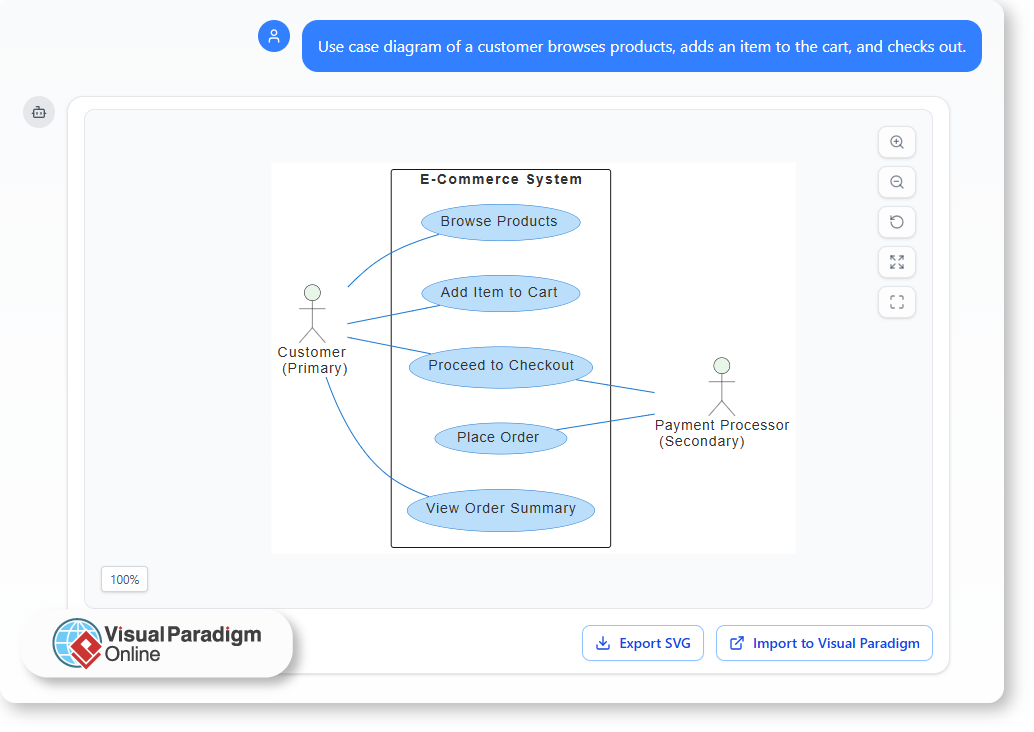Now Reading: From Textbooks to Chatbots: How AI Is Changing IT Education
-
01
From Textbooks to Chatbots: How AI Is Changing IT Education
From Textbooks to Chatbots: How AI Is Changing IT Education

For decades, IT education has relied on textbooks, static diagrams, and lengthy explanations to teach concepts like software architecture, databases, and system design. These methods work — but they often struggle to connect theory with real-world application. Students understand the “what,” but not always the “how.”
AI is changing that. With intelligent modeling assistants now available in tools like Visual Paradigm Online, learners can describe a concept in plain language and instantly see it visualized as a diagram. What once took hours of manual work now happens in seconds, bridging the gap between knowledge and practice.
The Limitation of Traditional Learning
Traditional IT education follows a predictable path:
- Students read definitions and examples in textbooks.
- They manually draw UML diagrams to illustrate system behavior.
- Instructors review diagrams and provide feedback.
This process is valuable but slow. The focus often shifts from understanding system logic to simply remembering symbols and syntax. Visualizing ideas becomes an exercise in drawing, not thinking.
As a result, many learners struggle to apply what they learn to practical situations — especially when they cannot immediately test or visualize their understanding.
How AI Makes Learning Interactive
AI modeling assistants are turning static theory into interactive learning experiences. Instead of starting from a blank canvas, students can simply type what they understand about a scenario, and the AI translates that description into a visual model.
For example, a student studying use case diagrams might type:
“Use case diagram of a customer browses products, adds an item to the cart, and checks out.”

Within moments, an AI tool can generate a use case diagram showing the actor, system boundary, and related actions. The student can then refine it, compare it with textbook examples, and immediately see the relationship between textual requirements and visual representation.
This instant feedback loop strengthens comprehension — turning abstract definitions into concrete understanding.
From Reading to Experimentation
AI tools encourage experimentation. Instead of memorizing notation, students can explore how diagrams change when they adjust their descriptions:
- Add new actors or processes and observe how relationships evolve.
- Describe system components and see how they connect in a class or component diagram.
- Compare different types of diagrams (use case, activity, sequence) based on the same scenario.
This approach transforms learning from passive reading to active discovery. It allows learners to ask “what if” questions and test their ideas immediately, deepening both intuition and confidence.
The Role of Chat-Based Learning
What makes this shift even more impactful is the chat-based experience. Students can communicate with AI in natural language, ask questions, and refine diagrams step by step.
In platforms like Visual Paradigm’s AI Chatbot, every conversation becomes part of the learning journey. Students can revisit the chat history to see how their understanding developed, compare iterations, and reflect on how each prompt shaped the final diagram.
This conversational, iterative approach mirrors how real developers refine designs — through discussion, revision, and validation — making learning both engaging and authentic.
Benefits for Educators and Institutions
AI-powered modeling does not just help students; it supports instructors too.
- Faster feedback: Teachers can quickly assess student understanding through AI-generated models.
- Personalized learning: Each student can progress at their own pace, guided by real-time visual feedback.
- Reduced workload: AI handles repetitive diagramming, freeing educators to focus on deeper conceptual discussions.
- Collaborative projects: Shared diagrams and chat histories encourage teamwork and peer learning.
It creates a more dynamic, technology-enhanced classroom — one that reflects the real environments students will encounter in the industry.
A New Era of Visual Learning
The move from textbooks to chatbots represents more than a technological upgrade — it is a shift in how IT knowledge is experienced. Instead of studying static examples, learners now create, interact, and refine in real time.
By combining natural language with AI-generated modeling, tools like Visual Paradigm’s AI Chatbot bring theory to life, helping students visualize logic, explore ideas freely, and gain a deeper, more intuitive understanding of system design.
AI is not replacing education; it is making it more vivid, practical, and interactive — exactly what IT learning has always needed.




